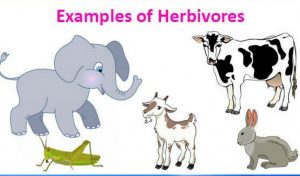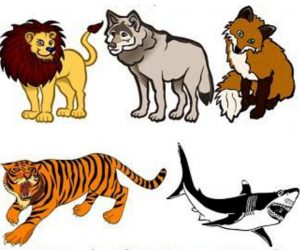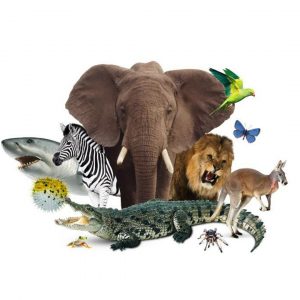Differences Between Herbivores And Carnivores: Examining an animal’s nutrition and feeding patterns is one method of classifying them. Animals that fall into these two categories are herbivores and carnivores. There is a principal distinction between herbivores and carnivores res respectively. Animals that solely consume plant matter are known as herbivores, while carnivores only consume meat.

The animals that fall under these two categories vary greatly from one another and one another’s diets. Many of their physiological characteristics, particularly the mouth and digestive system, are developed based on their food habits. Through food chains, the presence of species in these two categories is very helpful in preserving the ecosystem’s energy balance. Detailing the distinctions between herbivores and carnivores can be found below.
Recommended: Most Dangerous Animals in the World 2022
What are herbivores?
The energy animals are known as herbivores and are regarded as the base of the food chain. The energy that is kept in plants can be directly stored by them. Herbivores have distinctive teeth compared to carnivores and omnivores, such as large, flat, spade-shaped incisors, dull, short canines or none, and molars with flat cusps. Plant material is picked up with the canines and incisors and placed in the mouth; plant material is ground using molars with broad ridged surfaces.

Herbivores have a large chewing capacity since plant components are not particularly tasty. Their jaw point is situated directly above the plane of teeth for this reason. The saliva of herbivores contains digestive enzymes for carbohydrates.
However, omnivores and carnivores are unlikely to experience this (except in humans). The stomach can have one or more chambers, which with plant material digestion. Herbivores have short intestines that are 10–12 times longer than their bodies, which increases the surface area of nutrients that can be absorbed. They have a long colon and the ability to sacculate, just like humans.
Also see: Most Protected Buildings in the world 2022
What are carnivores?
Animals classified as carnivores only consume the meat of other animals. Carnivores are characterized by the presence of huge canines with razor-sharp edges that are intended for stabbing and shredding the victim. Additionally, their incisors have short, pointy ridges, and their molars have jagged edges that aid in grabbing and tearing the skin. Carnivores, like omnivores, do not have any digesting enzymes in their saliva.

Additionally, its small intestine is 3-6 times longer than its total length. Unlike herbivores, its liver can detoxify Vitamin A. Sharp claws have been fashioned out of the nails. The carnivores also have a specific adaption that aids in catching their prey, similar to how herbivores have unique adaptations.
There are many facts about carnivorous creatures. According to these details, the following descriptions of these animals apply: Red pandas and raccoons, who are carnivores, rarely eat meat. Not every carnivorous species consumes only meat. Only their mouths can move up and down in these creatures. They are unable to move their jaws to the side. There is a single common ancestor among all carnivores. They have a straightforward digestive system that is well-organized. Some examples of social carnivorous animals are wolves, lions, and dogs.

Recommended: Cutest Animals in the World 2022
Key Difference Between Herbivores and Carnivores
1. Animals classified as herbivores are those that only eat plants and their byproducts. Carnivores, on the other hand, are classified as animals that eat the flesh of other animals. These creatures have incredibly small mouth openings and eat with their mouths. while These animals have incredibly big mouth openings and rip the flesh apart with their teeth.
2. The sophisticated facial muscles of herbivores. Carnivores have weaker face muscles than other animals. The ratio of the mouth to its head is minimal in these animals. The ratio of a carnivore’s mouth to its head is excessive. Animals that are herbivores have broad, flat, and short teeth that are used for grinding and chomping plant leaves, grains, and seeds. Animals that are carnivores have long, pointed, and curved incisors and canines that are used to rip flesh.
Also see: Importance of Mathematics in Our Daily Lives
3. Their saliva contains digesting enzymes for herbivores. But carnivores, hence their saliva lacks digesting enzymes. The stomachs of herbivores can be either simple or multi-chambered. While carnivores have a straightforward stomach with just one chamber. The small intestine of herbivores is twice as long as their body size. Carnivores have short intestines that are of their body length.
4. Herbivores have urine that is only slightly concentrated. Carnivores have incredibly concentrated pee. Only plants and other greenery are eaten by herbivores. Carnivores mostly eat herbivores, as opposed to other animals.
Sharp incisors and effective grinding teeth are features of herbivore teeth. Carnivores have teeth that grind and have sharp canines. Numerous stomach chambers are present in most herbivores. In comparison to carnivores, they also have a longer digestive tract. Ruminants are those animals with several stomach chambers.
Digestion is substantially easier for carnivores. Additionally, they only have a single stomach chamber and a shorter digestive system.
Also see: Merits and Demerits of Unitary System of Government
5. The body proportions of herbivores are smaller and they are not designed for hunting. Carnivores, meanwhile, have larger, more aggressive body proportions. The claws of herbivores are blunt and flat. Carnivores, on the other hand, use their long, keen claws to hunt their prey.
Herbivores can be divided into different types according to the kind of plant matter they consume. Eaters of seeds, leaves, fruits, and nectar are known as granivores, folivores, and nectarines, respectively. Obligate carnivores and facultative carnivores are further categories of carnivores. While facultative carnivores can thrive on a combination of meat and a non-animal diet, obligatory carnivores must consume meat exclusively.
Also see: Differences Between Argument And Debate
6. Herbivores eat plant things, hence they have teeth made just for that purpose. For instance, cows can chew up plant material because of their big, flat teeth. Carnivores, in contrast, have teeth that are skilled at hunting and digesting meat.
For instance, lions have broad, pointed canines and sharp incisors. Even their molars can slice through meat. Herbivores have teeth and skulls that are specialized for crushing tough plants. Carnivores have skulls that can deliver powerful bites.
7. Herbivores have amylase in their saliva to aid in the breakdown of plant matter’s abundant carbohydrates and coarse fiber. Amylase is not produced in the saliva of carnivores.
They must rely on their pancreas to process carbohydrates instead. Numerous species of herbivores are examples. Folivores: Koalas and sloths Gray squirrels and capybara are granivores. Kakapo, Grey parrot, and white cockatoo are frugivores. Hummingbirds are nectarivorous. Carnivore examples include, among others. Lions and tigers are obligatory carnivores. Dogs are facultative carnivores.
Recommended: Importance Of Biology to the Society and our Daily Life
Conclusion
The majority of animals in the natural world get their energy needs met by other creatures. This idea allows us to divide eating patterns into two groups: herbivores and carnivores. We looked at how these two differ from one another in this article. Above is a summary of the differences between herbivores and carnivores.

Edeh Samuel Chukwuemeka, ACMC, is a lawyer and a certified mediator/conciliator in Nigeria. He is also a developer with knowledge in various programming languages. Samuel is determined to leverage his skills in technology, SEO, and legal practice to revolutionize the legal profession worldwide by creating web and mobile applications that simplify legal research. Sam is also passionate about educating and providing valuable information to people.